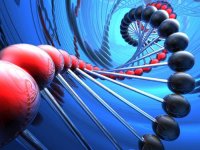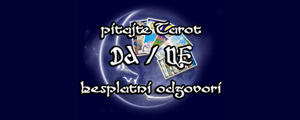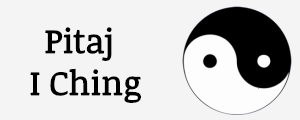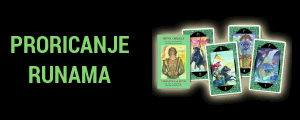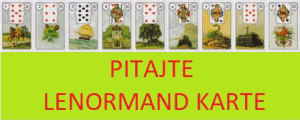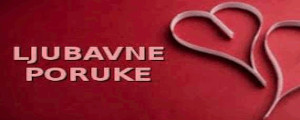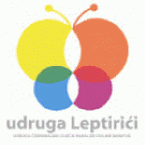7. COSMIC APPRENTICE
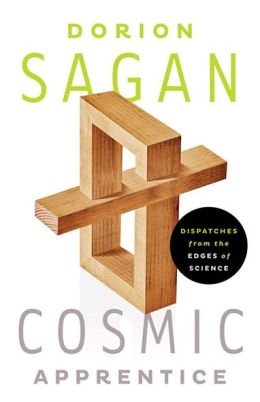 As if to define what science is and what philosophy is weren’t hard enough, to delineate how the two fit together appears a formidable task, one that has spurred rather intense opinions. But that’s precisely what Dorion Sagan, who has previously examined the prehistoric history of sex, braves in the introduction to Cosmic Apprentice: Dispatches from the Edges of Science (public library) as he sets out to explore the intricate ways in which the two fields hang “in a kind of odd balance, watching each other, holding hands”:
As if to define what science is and what philosophy is weren’t hard enough, to delineate how the two fit together appears a formidable task, one that has spurred rather intense opinions. But that’s precisely what Dorion Sagan, who has previously examined the prehistoric history of sex, braves in the introduction to Cosmic Apprentice: Dispatches from the Edges of Science (public library) as he sets out to explore the intricate ways in which the two fields hang “in a kind of odd balance, watching each other, holding hands”:
The difference between science and philosophy is that the scientist learns more and more about less and less until she knows everything about nothing, whereas a philosopher learns less and less about more and more until he knows nothing about everything. There is truth in this clever crack, but, as Niels Bohr impressed, while the opposite of a trivial truth is false, the opposite of a great truth is another great truth.
I would say that applies to the flip side of the above flip takedown: Science’s eye for detail, buttressed by philosophy’s broad view, makes for a kind of alembic, an antidote to both. This intellectual electrum cuts the cloying taste of idealist and propositional philosophy with the sharp nectar of fact yet softens the edges of a technoscience that has arguably lost both its moral and its epistemological compass, the result in part of its being funded by governments and corporations whose relationship to the search for truth and its open dissemination can be considered problematic at best.
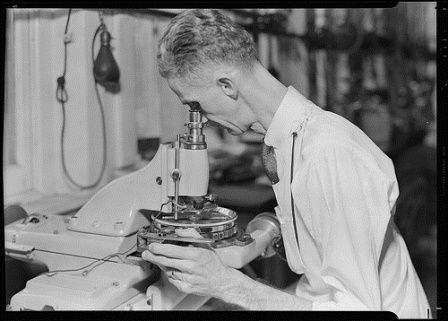
Sagan refutes the popular perception of science as rationally objective, a vessel of capital-T Truth, reminding us that every scientific concept and theory was birthed by a subjective, fallible human mind:
All observations are made from distinct places and times, and in science no less than art or philosophy by particular individuals. … Although philosophy isn’t fiction, it can be more personal, creative and open, a kind of counterbalance for science even as it argues that science, with its emphasis on a kind of impersonal materialism, provides a crucial reality check for philosophy and a tendency to overtheorize that [is] inimical to the scientific spirit. Ideally, in the search for truth, science and philosophy, the impersonal and autobiographical, can “keep each other honest,” in a kind of open circuit. Philosophy as the underdog even may have an advantage, because it’s not supposed to be as advanced as science, nor does it enjoy science’s level of institutional support — or the commensurate heightened risks of being beholden to one’s benefactors.
Like Richard Feynman, who argued tirelessly for the scientist’s responsibility to remain unsure, Sagan echoes the idea that willful ignorance is what drives science and the fear of being wrong is one of its greatest hindrances:
Science’s spirit is philosophical. It is the spirit of questioning, of curiosity, of critical inquiry combined with fact-checking. It is the spirit of being able to admit you’re wrong, of appealing to data, not authority, which does not like to admit it is wrong.
Sagan reflects on his father’s conviction that “the effort to popularize science is a crucial one for society,” one he shared with Richard Feynman, and what made Carl’s words echo as profoundly and timelessly as they do:
Science and philosophy both had a reputation for being dry, but my father helped inject life into the former, partly by speaking in plain English and partly by focusing on the science fiction fantasy of discovering extraterrestrial life.
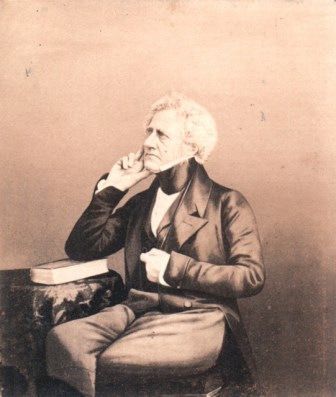
In that respect, science could learn from philosophy’s intellectual disposition:
Philosophy today, not taught in grade school in the United States, is too often merely an academic pursuit, a handmaiden or apologetics of science, or else a kind of existential protest, a trendy avocation of grad students and the dark-clad coffeehouse set. But philosophy, although it historically gives rise to experimental science, sometimes preserves a distinct mode of sustained questioning that sharply distinguishes it from modern science, which can be too quick to provide answers.
[…]
Philosophy is less cocksure, less already-knowing, or should be, than the pundits’ diatribes that relieve us of the difficulties of not knowing, of carefully weighing, of looking at the other side, of having to think things through for ourselves. Dwell in possibility, wrote Emily Dickinson: Philosophy at its best seems a kind of poetry, not an informational delivery but a dwelling, an opening of our thoughts to the world.
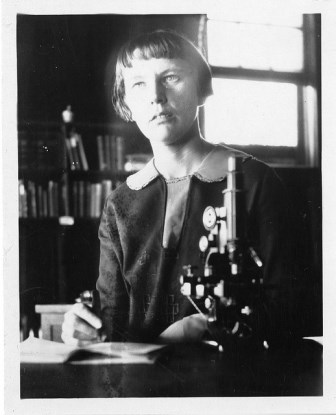
Like Buckminster Fuller, who vehemently opposed specialization, Sagan attests to the synergetic value of intellectual cross-pollination, attesting to the idea that true breakthroughs in science require cross-disciplinary connections and originality consists of linking up ideas whose connection was not previously suspected:
It is true that science requires analysis and that it has fractured into microdisciplines. But because of this, more than ever, it requires synthesis. Science is about connections. Nature no more obeys the territorial divisions of scientific academic disciplines than do continents appear from space to be colored to reflect the national divisions of their human inhabitants. For me, the great scientific satoris, epiphanies, eurekas, and aha! moments are characterized by their ability to connect.
“In disputes upon moral or scientific points,” advised Martine in his wonderful 1866 guide to the art of conversation, “ever let your aim be to come at truth, not to conquer your opponent. So you never shall be at a loss in losing the argument, and gaining a new discovery.” Science, Sagan suggests — at least at its most elegant — is a conversation of constant revision, where each dead end brings to life a new fruitful question:
Theories are not only practical, and wielded like intellectual swords to the death … but beautiful. A good one is worth more than all the ill-gotten hedge fund scraps in the world. A good scientific theory shines its light, revealing the world’s fearful symmetry. And its failure is also a success, as it shows us where to look next.
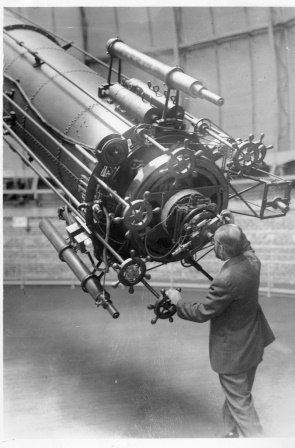
Supporting Neil deGrasse Tyson’s contention that intelligent design is a philosophy of ignorance, Sagan applies this very paradigm of connection-making to the crux of the age-old science vs. religion debate, painting evolution not as a tool of certitude but as a reminder of our connectedness to everything else:
Connecting humanity with other species in a single process was Darwin’s great natural historical accomplishment. It showed that some of the issues relegated to religion really come under the purview of science. More than just a research program for technoscience, it provides a eureka moment, a subject of contemplation open in principle to all thinking minds. Beyond the squabbles over its mechanisms and modes, evolution’s epiphany derives from its widening of vistas, its showing of the depths of our connections to others from whom we’d thought we were separate. Philosophy, too … in its ancient, scientifico-genic spirit of inquiry so different from a mere, let alone peevish, recounting of facts, needs to be reconnected to science for the latter to fulfill its potential not just as something useful but as a source of numinous moments, deep understanding, and indeed, religious-like epiphanies of cosmic comprehension and aesthetic contemplation.
Originally featured in April — see more here.
8. SOCIAL
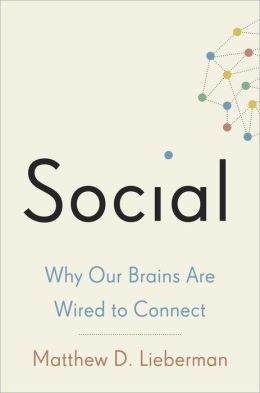 “Without the sense of fellowship with men of like mind,” Einstein wrote, “life would have seemed to me empty.” It is perhaps unsurprising that the iconic physicist, celebrated as “the quintessential modern genius,” intuited something fundamental about the inner workings of the human mind and soul long before science itself had attempted to concretize it with empirical evidence. Now, it has: In Social: Why Our Brains Are Wired to Connect (public library), neuroscientist Matthew D. Lieberman, director of UCLA’s Social Cognitive Neuroscience lab, sets out to “get clear about ‘who we are’ as social creatures and to reveal how a more accurate understanding of our social nature can improve our lives and our society. Lieberman, who has spent the past two decades using tools like fMRI to study how the human brain responds to its social context, has found over and over again that our brains aren’t merely simplistic mechanisms that only respond to pain and pleasure, as philosopher Jeremy Bentham famously claimed, but are instead wired to connect. At the heart of his inquiry is a simple question: Why do we feel such intense agony when we lose a loved one? He argues that, far from being a design flaw in our neural architecture, our capacity for such overwhelming grief is a vital feature of our evolutionary constitution:
“Without the sense of fellowship with men of like mind,” Einstein wrote, “life would have seemed to me empty.” It is perhaps unsurprising that the iconic physicist, celebrated as “the quintessential modern genius,” intuited something fundamental about the inner workings of the human mind and soul long before science itself had attempted to concretize it with empirical evidence. Now, it has: In Social: Why Our Brains Are Wired to Connect (public library), neuroscientist Matthew D. Lieberman, director of UCLA’s Social Cognitive Neuroscience lab, sets out to “get clear about ‘who we are’ as social creatures and to reveal how a more accurate understanding of our social nature can improve our lives and our society. Lieberman, who has spent the past two decades using tools like fMRI to study how the human brain responds to its social context, has found over and over again that our brains aren’t merely simplistic mechanisms that only respond to pain and pleasure, as philosopher Jeremy Bentham famously claimed, but are instead wired to connect. At the heart of his inquiry is a simple question: Why do we feel such intense agony when we lose a loved one? He argues that, far from being a design flaw in our neural architecture, our capacity for such overwhelming grief is a vital feature of our evolutionary constitution:
The research my wife and I have done over the past decade shows that this response, far from being an accident, is actually profoundly important to our survival. Our brains evolved to experience threats to our social connections in much the same way they experience physical pain. By activating the same neural circuitry that causes us to feel physical pain, our experience of social pain helps ensure the survival of our children by helping to keep them close to their parents. The neural link between social and physical pain also ensures that staying socially connected will be a lifelong need, like food and warmth. Given the fact that our brains treat social and physical pain similarly, should we as a society treat social pain differently than we do? We don’t expect someone with a broken leg to “just get over it.” And yet when it comes to the pain of social loss, this is a common response. The research that I and others have done using fMRI shows that how we experience social pain is at odds with our perception of ourselves. We intuitively believe social and physical pain are radically different kinds of experiences, yet the way our brains treat them suggests that they are more similar than we imagine.
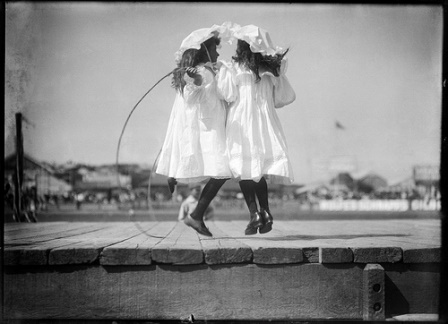
Citing his research, Lieberman affirms the notion that there is no such thing as a nonconformist, pointing out the social construction of what we call our individual “selves” — empirical evidence for what the novelist William Gibson so eloquently termed one’s “personal micro-culture” — and observes “our socially malleable sense of self”:
The neural basis for our personal beliefs overlaps significantly with one of the regions of the brain primarily responsible for allowing other people’s beliefs to influence our own. The self is more of a superhighway for social influence than it is the impenetrable private fortress we believe it to be.
Contextualizing it in a brief evolutionary history, he argues that this osmosis of sociality and individuality is an essential aid in our evolutionary development rather than an aberrant defect in it:
Our sociality is woven into a series of bets that evolution has laid down again and again throughout mammalian history. These bets come in the form of adaptations that are selected because they promote survival and reproduction. These adaptations intensify the bonds we feel with those around us and increase our capacity to predict what is going on in the minds of others so that we can better coordinate and cooperate with them. The pain of social loss and the ways that an audience’s laughter can influence us are no accidents. To the extent that we can characterize evolution as designing our modern brains, this is what our brains were wired for: reaching out to and interacting with others. These are design features, not flaws. These social adaptations are central to making us the most successful species on earth.

The implications of this span across everything from the intimacy of our personal relationships to the intricacy of organizational management and teamwork. But rather than entrusting a single cognitive “social network” with these vital functions, our brains turn out to host many. Lieberman explains:
Just as there are multiple social networks on the Internet such as Facebook and Twitter, each with its own strengths, there are also multiple social networks in our brains, sets of brain regions that work together to promote our social well-being.
These networks each have their own strengths, and they have emerged at different points in our evolutionary history moving from vertebrates to mammals to primates to us, Homo sapiens. Additionally, these same evolutionary steps are recapitulated in the same order during childhood.

He goes on to explore three major adaptations that have made us so inextricably responsive to the social world:
Connection: Long before there were any primates with a neocortex, mammals split off from other vertebrates and evolved the capacity to feel social pains and pleasures, forever linking our well-being to our social connectedness. Infants embody this deep need to stay connected, but it is present through our entire lives.
Mindreading: Primates have developed an unparalleled ability to understand the actions and thoughts of those around them, enhancing their ability to stay connected and interact strategically. In the toddler years, forms of social thinking develop that outstrip those seen in the adults of any other species. This capacity allows humans to create groups that can implement nearly any idea and to anticipate the needs and wants of those around us, keeping our groups moving smoothly.
Harmonizing: The sense of self is one of the most recent evolutionary gifts we have received. Although the self may appear to be a mechanism for distinguishing us from others and perhaps accentuating our selfishness, the self actually operates as a powerful force for social cohesiveness. During the preteen and teenage years, adolescent refers to the neural adaptations that allow group beliefs and values to influence our own.
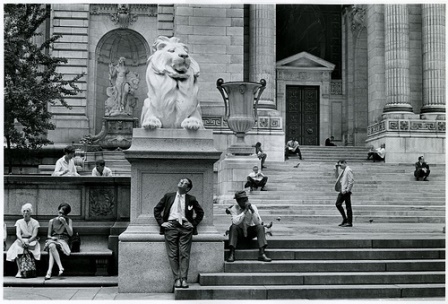
Originally featured in November — see more here, including Liberman’s fantastic TEDxStLouis talk.
9. GULP
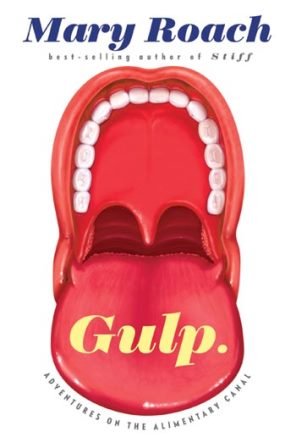 Few writers are able to write about science in a way that’s provocative without being sensationalistic, truthful without being dry, enchanting without being forced — and even fewer are able to do so on subjects that don’t exactly lend themselves to Saganesque whimsy. After all, it’s infinitely easier to inspire awe while discussing the bombastic magnificence of the cosmos than, say, the function of bodily fluids and the structures that secrete them. But Mary Roach is one of those rare writers, and that’s precisely what she proves once more in Gulp: Adventures on the Alimentary Canal (public library) — a fascinating tour of the body’s most private hydraulics.
Few writers are able to write about science in a way that’s provocative without being sensationalistic, truthful without being dry, enchanting without being forced — and even fewer are able to do so on subjects that don’t exactly lend themselves to Saganesque whimsy. After all, it’s infinitely easier to inspire awe while discussing the bombastic magnificence of the cosmos than, say, the function of bodily fluids and the structures that secrete them. But Mary Roach is one of those rare writers, and that’s precisely what she proves once more in Gulp: Adventures on the Alimentary Canal (public library) — a fascinating tour of the body’s most private hydraulics.
Roach writes in the introduction:
The early anatomists had that curiosity in spades. They entered the human form like an unexplored continent. Parts were named like elements of geography: the isthmus of the thyroid, the isles of the pancreas, the straits and inlets of the pelvis. The digestive tract was for centuries known as the alimentary canal. How lovely to picture one’s dinner making its way down a tranquil, winding waterway, digestion and excretion no more upsetting or off-putting than a cruise along the Rhine. It’s this mood, these sentiments — the excitement of exploration and the surprises and delights of travel to foreign locales — that I hope to inspire with this book.
It may take some doing. The prevailing attitude is one of disgust. … I remember, for my last book, talking to the public-affairs staff who choose what to stream on NASA TV. The cameras are often parked on the comings and goings of Mission Control. If someone spots a staffer eating lunch at his desk, the camera is quickly repositioned. In a restaurant setting, conviviality distracts us from the biological reality of nutrient intake and oral processing. But a man alone with a sandwich appears as what he is: an organism satisfying a need. As with other bodily imperatives, we’d rather not be watched. Feeding, and even more so its unsavory correlates, are as much taboos as mating and death.
The taboos have worked in my favor. The alimentary recesses hide a lode of unusual stories, mostly unmined. Authors have profiled the brain, the heart, the eyes, the skin, the penis and the female geography, even the hair, but never the gut. The pie hole and the feed chute are mine.
Roach goes on to bring real science to those subjects that make teenagers guffaw and that populate mediocre standup jokes, exploring such bodily mysteries as what flatulence research reveals about death, why tasting has little to do with taste, how thorough chewing can lower the national debt, and why we like the foods we like and loathe the rest.
10. WONDERS OF THE UNIVERSE
 “I know that I am mortal by nature and ephemeral,” ur-astronomer Ptolemy contemplated nearly two millennia ago, “but when I trace at my pleasure the windings to and fro of the heavenly bodies, I no longer touch earth with my feet. I stand in the presence of Zeus himself and take my fill of ambrosia.” But while the cosmos has fascinated humanity since the dawn of time, its mesmerism isn’t that of an abstract other but, rather, the very self-reflexive awareness that Ptolemy attested to, that intimate and inextricable link between the wonders of life here on Earth and the magic we’ve always found in our closest cosmic neighbors.
“I know that I am mortal by nature and ephemeral,” ur-astronomer Ptolemy contemplated nearly two millennia ago, “but when I trace at my pleasure the windings to and fro of the heavenly bodies, I no longer touch earth with my feet. I stand in the presence of Zeus himself and take my fill of ambrosia.” But while the cosmos has fascinated humanity since the dawn of time, its mesmerism isn’t that of an abstract other but, rather, the very self-reflexive awareness that Ptolemy attested to, that intimate and inextricable link between the wonders of life here on Earth and the magic we’ve always found in our closest cosmic neighbors.
That’s precisely what modern-day science-enchanter Brian Cox explores in Wonders of the Solar System (public library) — the fantastic and illuminating book based on his BBC series of the same title celebrating the spirit of exploration, and a follow-up to his Wonders of Life and every bit as brimming with his signature blend of enthralling storytelling, scientific brilliance, and contagious conviction.
Cox begins by reminding us that preserving the spirit of exploration is both a joy and a moral obligation — especially at a time when it faces tragic threats of indifference and neglect from the very authorities whose job it is to fuel it, despite a citizenry profoundly in love with the ethos of exploration:
[The spirit of exploration] is desperately relevant, an idea so important that celebration is perhaps too weak a word. It is a plea for the spirit of the navigators of the seas and the pioneers of aviation and spaceflight to be restored and cherished; a case made to the viewer and reader that reaching for worlds beyond our grasp is an essential driver of progress and necessary sustenance for the human spirit. Curiosity is the rocket fuel that powers our civilization. If we deny this innate and powerful urge, perhaps because earthly concerns seem more worthy or pressing, then the borders of our intellectual and physical domain will shrink with our ambitions. We are part of a much wider ecosystem, and our prosperity and even long-term survival are contingent on our understanding of it.
But most revelational of all is Cox’s gift from illustrating what our Earthly phenomena, right here on our seemingly ordinary planet, reveal about the wonders and workings of the Solar System.
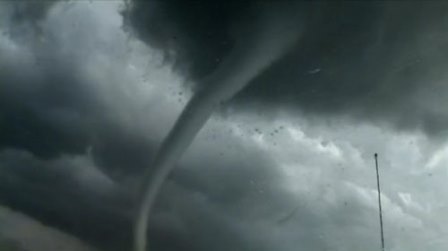
Tornadoes, for instance, tell us how our star system was born — the processes that drive these giant rotating storms obey the same physics forces that caused clumps to form at the center of nebulae five billion years ago, around which the gas cloud collapsed and began spinning ever-faster, ordering the chaos, until the early Solar System was churned into existence. This universal principle, known as the conservation of angular momentum, is also what drives a tornado’s destructive spiral.
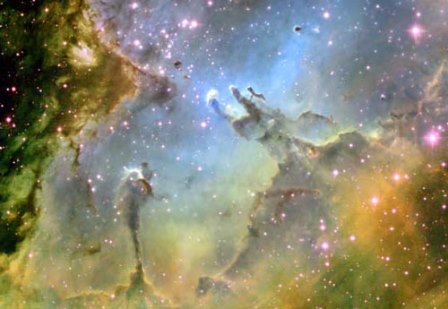
Cox synthesizes:
This is how our Solar System was born: rather than the whole system collapsing into the Sun, a disc of dust and gas extending billions of kilometers into space formed around the new shining star. In just a few hundred million years, pieces of the cloud collapsed to form planets and moons, and so a star system, our Solar System, was formed. The journey from chaos into order had begun.

Then we have Iceland’s icebergs and glacial lagoons, which offer remarkable insight into the nature of Saturn’s rings. Both shine with puzzling brightness — the lagoons, here on Earth, by bringing pure water that is thousands of years old and free of pollutants from the bottom of the seabed to the surface as they rise, forming ice crystals of exceptional vibrance; Saturn’s rings, young and ever-changing, by circling icy ring particles around the planet, constantly crashing them together and breaking them apart, thus exposing bright new facets of ice that catch the sunlight and dazzle amidst a Solar System that is otherwise “a very dirty place.”
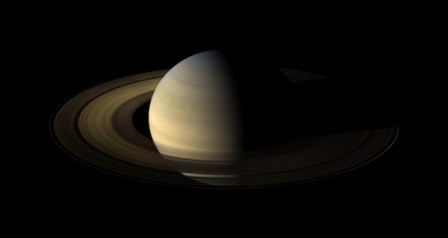
Cox explains:
It’s difficult to imagine the scale, beauty and intricacy of Saturn’s rings here on Earth, but the glacial lagoons of Iceland can transport our minds across millions of kilometers of space and help us understand the true nature of the rings. … At first sight, the lagoon appears to be a solid sheet of pristine ice,but this is an illusion. The surface is constantly shifting, an almost organic, every-changing raft of thousands of individual icebergs floating on the water. The structure of Saturn’s rings is similar, because despite appearances the rings aren’t solid. Each ring is made up of hundreds of ringlets and each ringlet is made up of billions of separate pieces. Captured by Saturn’s gravity, the ring particles independently orbit the panel in an impossibly thin layer.
Cox goes on to explore other such illuminating parallels, from how Alaska’s Lake Eyak illustrate the methane cycles of the universe to what Hawaii’s Big Island tells us about the forces that keep any planet alive to how the volcanic features of India’s Deccan Traps explain why Venus choked to death. He ends with T. S. Eliot’s timeless verses on the spirit of exploration and echoes Neil deGrasse Tyson’s wisdom on your ego and the cosmic perspective, concluding:
You could take the view that our exploration of the Universe has made us somehow insignificant; one tiny planet around one star amongst hundreds of billions. But I don’t take that view, because we’ve discovered that it takes the rarest combination of chance and the laws of Nature to produce a planet that can support a civilization, that most magnificent structure that allows us to explore and understand the Universe. That’s why, for me, our civilization is the wonder of the Solar System, and if you were to be looking at the Earth from outside the Solar System that much would be obvious. We have written the evidence of our existence onto the surface of our planet. Our civilization has become a beacon that identifies our planet as a home to life.
Originally featured in August — see more here.
11. SAVE OUR SCIENCE
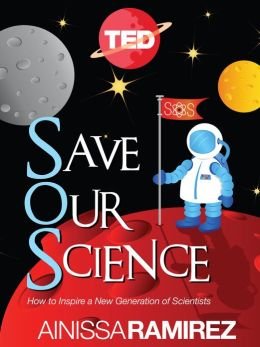 “What is crucial is not that technical ability, but it is imagination in all of its applications,” the great E. O. Wilson offered in his timeless advice to young scientists — a conviction shared by some of history’s greatest scientific minds. And yet it is rote memorization and the unimaginative application of technical skill that our dominant education system prioritizes — so it’s no wonder it is failing to produce the Edisons and Curies of our day. In Save Our Science: How to Inspire a New Generation of Scientists, materials scientist, inventor, and longtime Yale professor Ainissa Ramirez takes on a challenge Isaac Asimov presaged a quarter century ago, advocating for the value of science education and critiquing its present failures, with a hopeful and pragmatic eye toward improving its future. She writes in the introduction:
“What is crucial is not that technical ability, but it is imagination in all of its applications,” the great E. O. Wilson offered in his timeless advice to young scientists — a conviction shared by some of history’s greatest scientific minds. And yet it is rote memorization and the unimaginative application of technical skill that our dominant education system prioritizes — so it’s no wonder it is failing to produce the Edisons and Curies of our day. In Save Our Science: How to Inspire a New Generation of Scientists, materials scientist, inventor, and longtime Yale professor Ainissa Ramirez takes on a challenge Isaac Asimov presaged a quarter century ago, advocating for the value of science education and critiquing its present failures, with a hopeful and pragmatic eye toward improving its future. She writes in the introduction:
The 21st century requires a new kind of learner — not someone who can simply churn out answers by rote, as has been done in the past, but a student who can think expansively and solve problems resourcefully.
To do that, she argues, we need to replace the traditional academic skills of “reading, ’riting, and ’rithmetic” with creativity, curiosity, critical-thinking, and problem-solving. (Though, as psychology has recently revealed, problem-finding might be the more valuable skill.)
Ainissa Ramirez at TED 2012 (Photograph: James Duncan Davidson for TED)
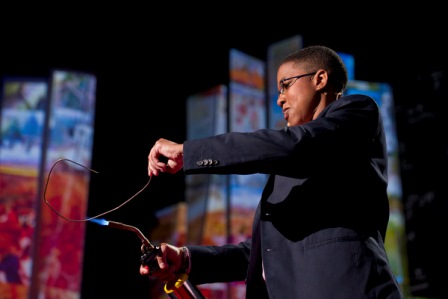
She begins with the basics:
While the acronym STEM sounds very important, STEM answers just three questions: Why does something happen? How can we apply this knowledge in a practical way? How can we describe what is happening succinctly? Through the questions, STEM becomes a pathway to be curious, to create, and to think and figure things out.
Even for those of us who deem STEAM (wherein the A stands for “arts”) superior to STEM, Ramirez’s insights are razor-sharp and consistent with the oft-affirmed idea that creativity relies heavily upon connecting the seemingly disconnected and aligning the seemingly misaligned:
There are two schools of thought on defining creativity: divergent thinking, which is the formation of a creative idea resulting from generating lots of ideas, and a Janusian approach, which is the act of making links between two remote ideas. The latter takes its name from the two-faced Roman god of beginnings, Janus, who was associated with doorways and the idea of looking forward and backward at the same time. Janusian creativity hinges on the belief that the best ideas come from linking things that previously did not seem linkable. Henri Poincaré, a French mathematician, put it this way: ‘To create consists of making new combinations. … The most fertile will often be those formed of elements drawn from domains which are far apart.’
Another element inherent to the scientific process but hardly rewarded, if not punished, in education is the role of ignorance, or what the poet John Keats has eloquently and timelessly termed “negative capability” — the art of brushing up against the unknown and proceeding anyway. Ramirez writes:
My training as a scientist allows me to stare at an unknown and not run away, because I learned that this melding of uncertainty and curiosity is where innovation and creativity occur.
Yet these very qualities are missing from science education in the United States — and it shows. When the Programme for International Student Assessment (PISA) took their annual poll in 2006, the U.S. ranked 35th in math and 29th in science out of the 40 high-income, developed countries surveyed.
Average PISA scores versus expenditures for selected countries (Source: Organisation for Economic Co-operation and Development)

Ramirez offers a historical context: When American universities first took root in the colonial days, their primary role was to educate men for the clergy, so science, technology, and math were not a priority. But then Justin Smith Morrill, a little-known congressman from Vermont who had barely completed his high school education, came along in 1861 and quietly but purposefully sponsored legislation that forever changed American education, resulting in more than 70 new colleges and universities that included STEM subjects in their curricula. This catapulted enrollment rates from the mere 2% of the population who attended higher education prior to the Civil War and greatly increased diversity in academia, with the act’s second revision in 1890 extending education opportunities to women and African-Americans.
The growth of U.S. college enrollment from 1869 to 1994. (Source: S. B. Carter et al., Historical Statistics of the United States)
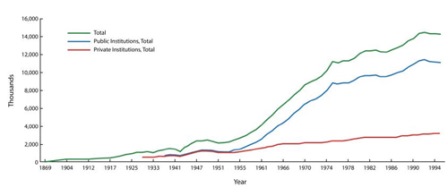
But what really propelled science education, Ramirez notes, was the competitive spirit of the Space Race:
The mixture of being outdone and humiliated motivated the U.S. to create NASA and bolster the National Science Foundation’s budget to support science research and education. Sputnik forced the U.S. to think about its science position and to look hard into a mirror — and the U.S. did not like what it saw. In 1956, before Sputnik, the National Science Foundation’s budget was a modest $15.9 million. In 1958, it tripled to $49.5 million, and it doubled again in 1959 to $132.9 million. The space race was on. We poured resources, infrastructure, and human capital into putting an American on the moon, and with that goal, STEM education became a top priority.
President John F. Kennedy addresses a crowd of 35,000 at Rice University in 1962, proclaiming again his desire to reach the moon with the words, 'We set sail on this new sea because there is new knowledge to be gained.' Credit: NASA / Public domain
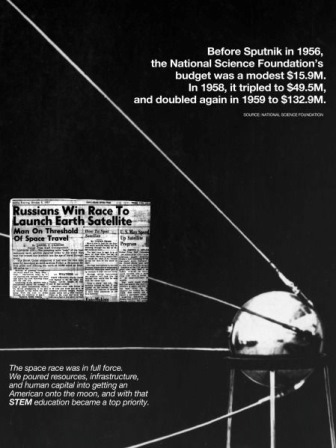
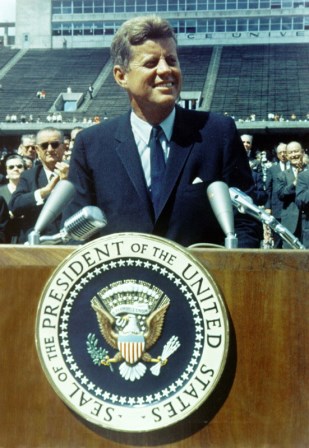
Ramirez argues for returning to that spirit of science education as an investment in national progress:
The U.S. has a history of changing education to meet the nation’s needs. We need similar innovative forward-thinking legislation now, to prepare our children and our country for the 21st century. Looking at our history allows us to see that we have been here before and prevailed. Let’s meet this challenge, for it will, as Kennedy claimed, draw out the very best in all of us.
In confronting the problems that plague science education and the public’s relationship with scientific culture, Ramirez points to the fact that women account for only 26% of STEM bachelor’s degrees and explores the heart of the glaring gender problem:
[There is a] false presumption that girls are not as good as boys in science and math. This message absolutely pervades our national mindset. Even though girls and boys sit next to each other in class, fewer women choose STEM careers than men. This is the equivalent to a farmer sowing seeds and then harvesting only half of the fields.
The precipitous drop in girls’ enrollment in STEM classes. (Source: J. F. Latimer, What’s Happened To Our High Schools)
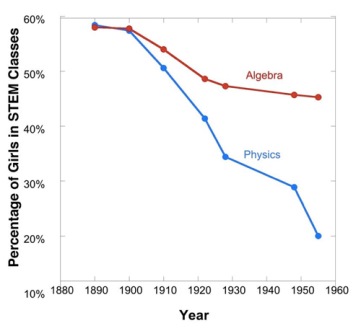
In turning toward possible solutions, Ramirez calls out the faulty models of standardized testing, which fail to account for more dimensional definitions of intelligence. She writes:
There is a concept in physics that the observer of an experiment can change the results just by the act of observing (this is called, not surprisingly, the observer effect). For example, knowing the required pressure of your tires and observing that they are overinflated dictates that you let some air out, which changes the pressure slightly.
Although this theory is really for electrons and atoms, we also see it at work in schools. Schools are evaluated, by the federal and state governments, by tests. The students are evaluated by tests administered by the teachers. It is the process of testing that has changed the mission of the school from instilling a wide knowledge of the subject matter to acquiring a good score on the tests.
The United States is one of the most test-taking countries in the world, and the standard weapon is the multiple-choice question. Although multiple-choice tests are efficient in schools, they don’t inspire learning. In fact, they do just the opposite. This is hugely problematic in encouraging the skills needed for success in the 21st century. Standardized testing teaches skills that are counter to skills needed for the future, such as curiosity, problem solving, and having a healthy relationship with failure. Standardized tests draw up a fear of failure, since you seek a specific answer and you will be either right or wrong; they kick problem solving in the teeth, since you never need to show your work and never develop a habit of figuring things out; and they slam the doors to curiosity, since only a small selection of the possible answers is laid out before you. These kinds of tests produce thinkers who are unwilling to stretch and take risks and who cannot handle failure. They crush a sense of wonder.
Like Noam Chomsky, who has questioned why schools train for passing tests rather than for creative inquiry, and Sir Ken Robinson, who has eloquently advocated for changing the factory model of education, Ramirez urges:
While scientists passionately explore, reason, discover, synthesize, compare, contrast, and connect the dots, students drudgingly memorize, watch, and passively consume. Students are exercising the wrong muscle. An infusion of STEM taught in compelling ways will give students an opportunity to acquire these active learning skills.
Ramirez goes on to propose a multitude of small changes and larger shifts that communities, educators, cities, institutions, and policy-makers could implement — from neighborhood maker-spaces to wifi hotspots on school buses to university science festivals to new curricula and testing methods — that would begin to bridge the gap between what science education currently is and what scientific culture could and should be. She concludes, echoing Alvin Toffler’s famous words that “the illiterate of the 21st century will not be those who cannot read and write, but those who cannot learn, unlearn, and relearn”:
The skills of the 21st century need us to create scholars who can link the unlinkable. … Nurturing curious, creative problem solvers who can master the art of figuring things out will make them ready for this unknown brave new world. And that is the best legacy we can possibly leave.
Originally featured in February — see more here.
12. THE ELEMENTS OF EUCLID
 Almost a century before Mondrian made his iconic red, yellow, and blue geometric compositions, and around the time that Edward Livingston Youmans was creating his stunning chemistry diagrams, an eccentric 19th-century civil engineer and mathematician named Oliver Byrne produced a striking series of vibrant diagrams in primary colors for a 1847 edition of the legendary Greek mathematical treatise Euclid’s Elements. Byrne, a vehement opponent of pseudoscience with an especial distaste phrenology, was early to the insight that great design and graphic elegance can powerfully aid learning. He explained that in his edition of Euclid, “coloured diagrams and symbols are used instead of letters for the greater ease of learners.” The book, a masterpiece of Victorian printing and graphic design long before “graphic design” existed as a discipline, is celebrated as one of the most unusual and most beautiful books of the 19th century.
Almost a century before Mondrian made his iconic red, yellow, and blue geometric compositions, and around the time that Edward Livingston Youmans was creating his stunning chemistry diagrams, an eccentric 19th-century civil engineer and mathematician named Oliver Byrne produced a striking series of vibrant diagrams in primary colors for a 1847 edition of the legendary Greek mathematical treatise Euclid’s Elements. Byrne, a vehement opponent of pseudoscience with an especial distaste phrenology, was early to the insight that great design and graphic elegance can powerfully aid learning. He explained that in his edition of Euclid, “coloured diagrams and symbols are used instead of letters for the greater ease of learners.” The book, a masterpiece of Victorian printing and graphic design long before “graphic design” existed as a discipline, is celebrated as one of the most unusual and most beautiful books of the 19th century.
Now, the fine folks of Taschen — who have brought us such visual treasures as the best illustrations from 150 years of Hans Christian Andersen, the life and legacy of infographics godfather Fritz Kahn, and the visual history of magic — are resurrecting Byrne’s gem in the lavish tome The First Six Books of the Elements of Euclid (public library), edited by Swiss polymath Werner Oechslin.
Proof of the Pythagorean theorem
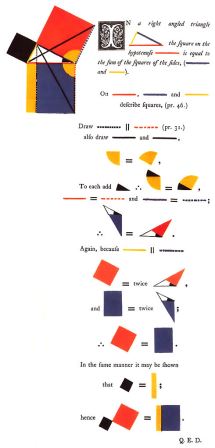
A masterwork of art and science in equal measure, this newly rediscovered treasure mesmerizes the eye with its brightly colored circles, squares, and triangles while it tickles the brain with its mathematical magic.
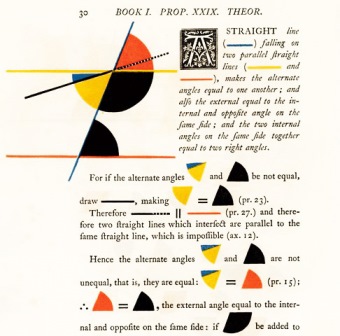
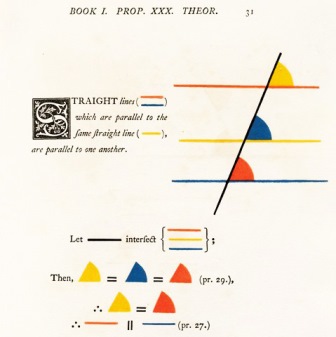
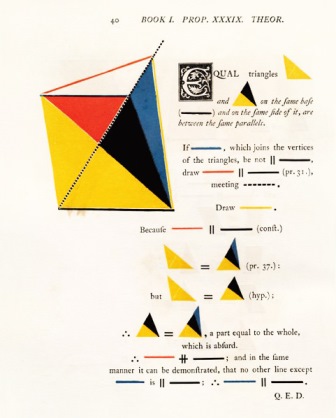
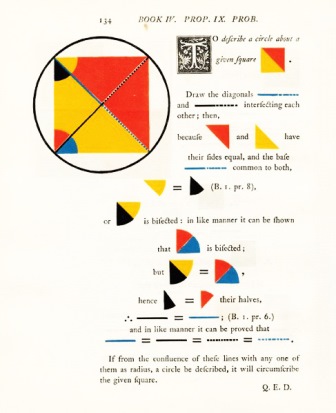
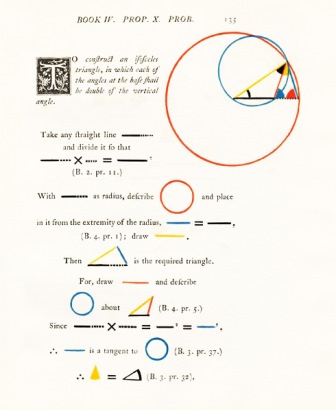
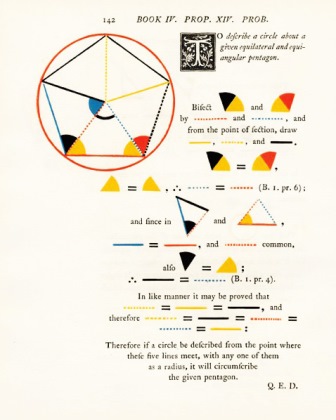
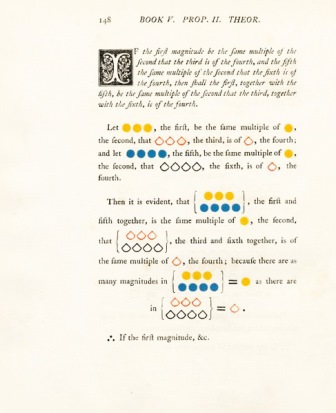
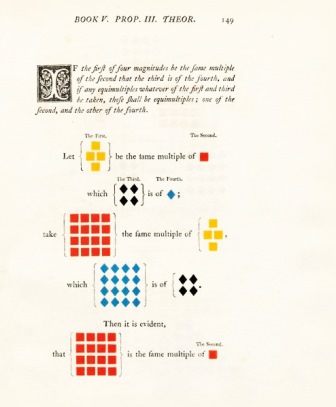
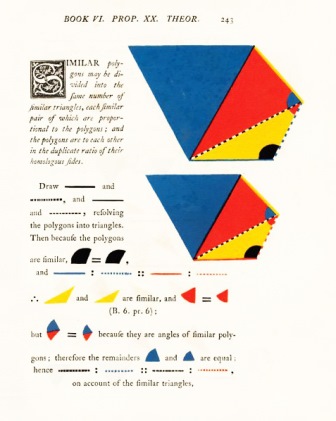
Originally featured in November — see more here.
13. DOES MY GOLDFISH KNOW WHO I AM?
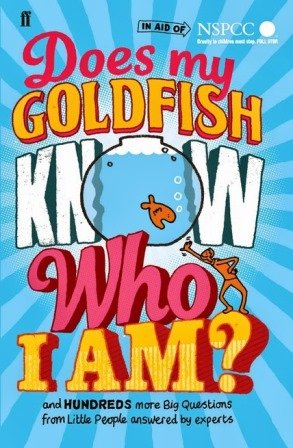 In 2012, I wrote about a lovely book titled Big Questions from Little People & Simple Answers from Great Minds, in which some of today’s greatest scientists, writers, and philosophers answer kids’ most urgent questions, deceptively simple yet profound. It went on to become one of the year’s best books and among readers’ favorites. A few months later, Gemma Elwin Harris, the editor who had envisioned the project, reached out to invite me to participate in the book’s 2013 edition by answering one randomly assigned question from a curious child. Naturally, I was thrilled to do it, and honored to be a part of something as heartening as Does My Goldfish Know Who I Am? (public library), also among the best children’s books of the year — a compendium of primary school children’s funny, poignant, innocent yet insightful questions about science and how life works, answered by such celebrated minds as rockstar physicist Brian Cox, beloved broadcaster and voice-of-nature Sir David Attenborough, legendary linguist Noam Chomsky, science writer extraordinaire Mary Roach, stat-showman Hans Rosling, Beatle Paul McCartney, biologist and Beagle Project director Karen James, and iconic illustrator Sir Quentin Blake. As was the case with last year’s edition, more than half of the proceeds from the book — which features illustrations by the wonderful Andy Smith — are being donated to a children’s charity.
In 2012, I wrote about a lovely book titled Big Questions from Little People & Simple Answers from Great Minds, in which some of today’s greatest scientists, writers, and philosophers answer kids’ most urgent questions, deceptively simple yet profound. It went on to become one of the year’s best books and among readers’ favorites. A few months later, Gemma Elwin Harris, the editor who had envisioned the project, reached out to invite me to participate in the book’s 2013 edition by answering one randomly assigned question from a curious child. Naturally, I was thrilled to do it, and honored to be a part of something as heartening as Does My Goldfish Know Who I Am? (public library), also among the best children’s books of the year — a compendium of primary school children’s funny, poignant, innocent yet insightful questions about science and how life works, answered by such celebrated minds as rockstar physicist Brian Cox, beloved broadcaster and voice-of-nature Sir David Attenborough, legendary linguist Noam Chomsky, science writer extraordinaire Mary Roach, stat-showman Hans Rosling, Beatle Paul McCartney, biologist and Beagle Project director Karen James, and iconic illustrator Sir Quentin Blake. As was the case with last year’s edition, more than half of the proceeds from the book — which features illustrations by the wonderful Andy Smith — are being donated to a children’s charity.
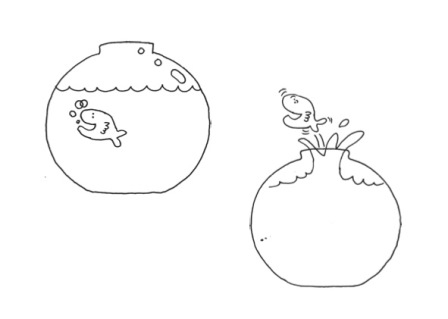
The questions range from what the purpose of science is to why onions make us cry to whether spiders can speak to why we blink when we sneeze. Psychologist and broadcaster Claudia Hammond, who recently explained the fascinating science of why time slows down when we’re afraid, speeds up as we age, and gets all warped while we’re on vacation in one of the best psychology and philosophy books of 2013, answers the most frequently asked question by the surveyed children: Why do we cry?
It’s normal to cry when you feel upset and until the age of twelve boys cry just as often as girls. But when you think about it, it is a bit strange that salty water spills out from the corners of your eyes just because you feel sad.
One professor noticed people often say that, despite their blotchy faces, a good cry makes them feel better. So he did an experiment where people had to breathe in over a blender full of onions that had just been chopped up. Not surprisingly this made their eyes water. He collected the tears and put them in the freezer. Then he got people to sit in front of a very sad film wearing special goggles which had tiny buckets hanging off the bottom, ready to catch their tears if they cried. The people cried, but the buckets didn’t work and in the end he gathered their tears in tiny test tubes instead.
He found that the tears people cried when they were upset contained extra substances, which weren’t in the tears caused by the onions. So he thinks maybe we feel better because we get rid of these substances by crying and that this is the purpose of tears.
But not everyone agrees. Many psychologists think that the reason we cry is to let other people know that we need their sympathy or help. So crying, provided we really mean it, brings comfort because people are nice to us.
Crying when we’re happy is a bit more of a mystery, but strong emotions have a lot in common, whether happy or sad, so they seem to trigger some of the same processes in the body.
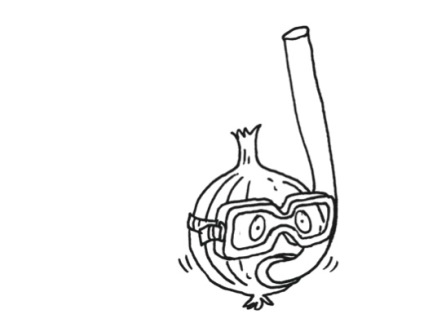
(For a deeper dive into the biological mystery of crying, see the science of sobbing and emotional tearing.)
Joshua Foer, who knows a thing or two about superhuman memory and the limits of our mind, explains to 9-year-old Tom how the brain can store so much information despite being that small:
An adult’s brain only weighs about 1.4 kilograms, but it’s made up of about 100 billion microscopic neurons. Each of those neurons looks like a tiny branching tree, whose limbs reach out and touch other neurons. In fact, each neuron can make between 5,000 and 10,000 connections with other neurons — sometimes even more. That’s more than 500 trillion connections! A memory is essentially a pattern of connections between neurons.
Every sensation that you remember, every thought that you think, transforms your brain by altering the connections within that vast network. By the time you get to the end of this sentence, you will have created a new memory, which means your brain will have physically changed.
Neuroscientist Tali Sharot, who has previously studied why our brains are wired for optimism, answers 8-year-old Maia’s question about why we don’t have memories from the time we were babies and toddlers:
We use our brain for memory. In the first few years of our lives, our brain grows and changes a lot, just like the rest of our body. Scientists think that because the parts of our brain that are important for memory have not fully developed when we are babies, we are unable to store memories in the same way that we do when we are older.
Also, when we are very young we do not know how to speak. This makes it difficult to keep events in your mind and remember them later, because we use language to remember what happened in the past.
In answering 8-year-old Hannah’s question about what newspapers do when there is no news, writer and journalist Oliver Burkeman, author of the excellent The Antidote: Happiness for People Who Can’t Stand Positive Thinking, offers a primer on media literacy — an important caveat on news that even we, as alleged grown-ups, frequently forget:
Newspapers don’t really go out and find the news: they decide what gets to count as news. The same goes for television and radio. And you might disagree with their decisions! (For example, journalists are often accused of focusing on bad news and ignoring the good, making the world seem worse than it is.)
The important thing to remember, whenever you’re reading or watching the news, is that someone decided to tell you those things, while leaving out other things. They’re presenting one particular view of the world — not the only one. There’s always another side to the story.
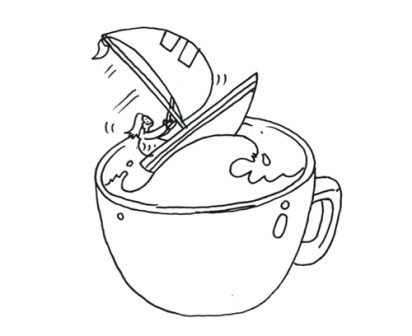
And my answer, to 9-year-old Ottilie’s question about why we have books:
Some people might tell you that books are no longer necessary now that we have the internet. Don’t believe them. Books help us know other people, know how the world works, and, in the process, know ourselves more deeply in a way that has nothing to with what you read them on and everything to do with the curiosity, integrity and creative restlessness you bring to them.
Books build bridges to the lives of others, both the characters in them and your countless fellow readers across other lands and other eras, and in doing so elevate you and anchor you more solidly into your own life. They give you a telescope into the minds of others, through which you begin to see with ever greater clarity the starscape of your own mind.
And though the body and form of the book will continue to evolve, its heart and soul never will. Though the telescope might change, the cosmic truths it invites you to peer into remain eternal like the Universe.
In many ways, books are the original internet — each fact, each story, each new bit of information can be a hyperlink to another book, another idea, another gateway into the endlessly whimsical rabbit hole of the written word. Just like the web pages you visit most regularly, your physical bookmarks take you back to those book pages you want to return to again and again, to reabsorb and relive, finding new meaning on each visit — because the landscape of your life is different, new, “reloaded” by the very act of living.
Originally featured in November — read more of the questions and answers here.
HONORABLE MENTIONS
The Space Book: From the Beginning to the End of Time, 250 Milestones in the History of Space & Astronomy by Jim Bell, An Appetite for Wonder: The Making of a Scientist by Richard Dawkins, and The Age of Edison: Electric Light and the Invention of Modern America by Ernest Freeberg.
Donating = Loving
Bringing you (ad-free) Brain Pickings takes hundreds of hours each month. If you find any joy and stimulation here, please consider becoming a Supporting Member with a recurring monthly donation of your choosing, between a cup of tea and a good dinner:
http://www.brainpickings.org/index.php/
2013/12/10/best-science-technology-books-2013/



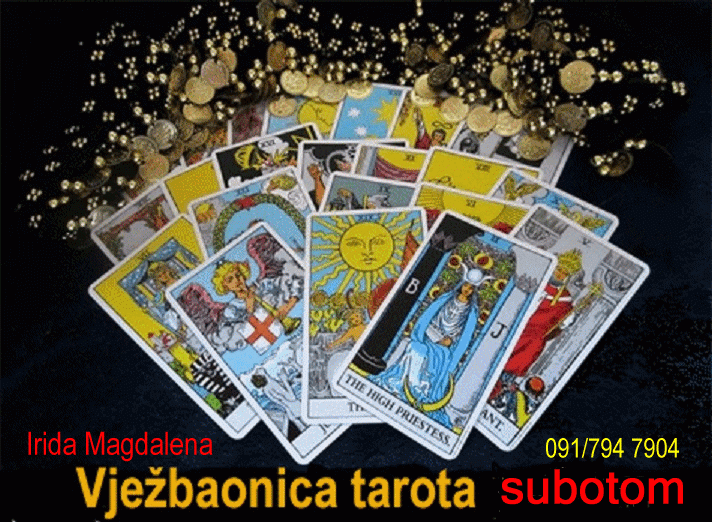
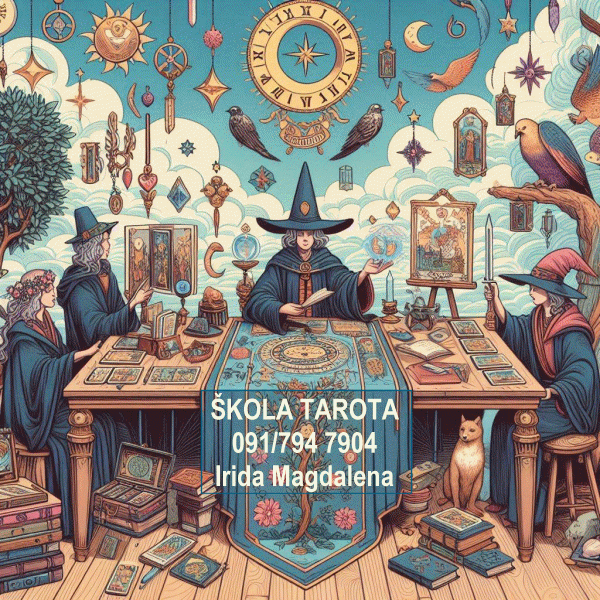

































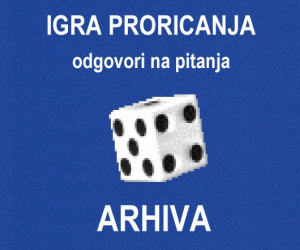










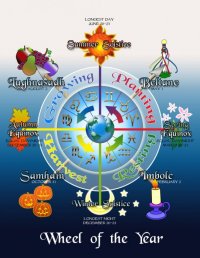




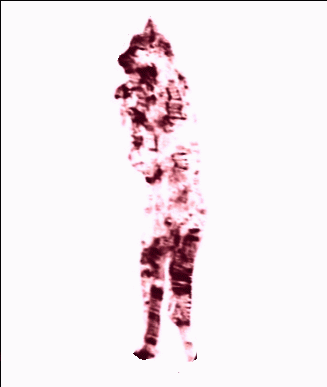 edin.kecanovic
edin.kecanovic irida
irida bglavac
bglavac










